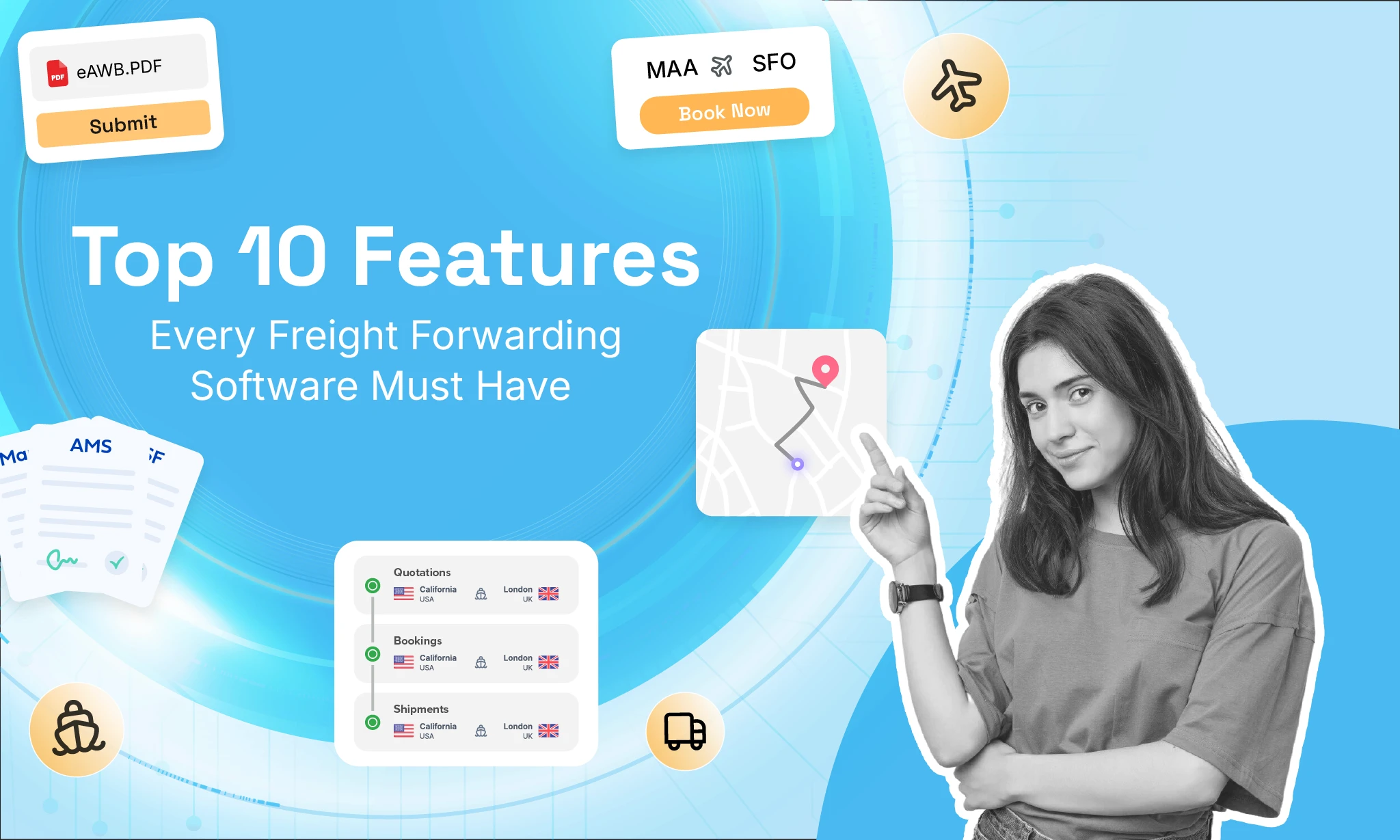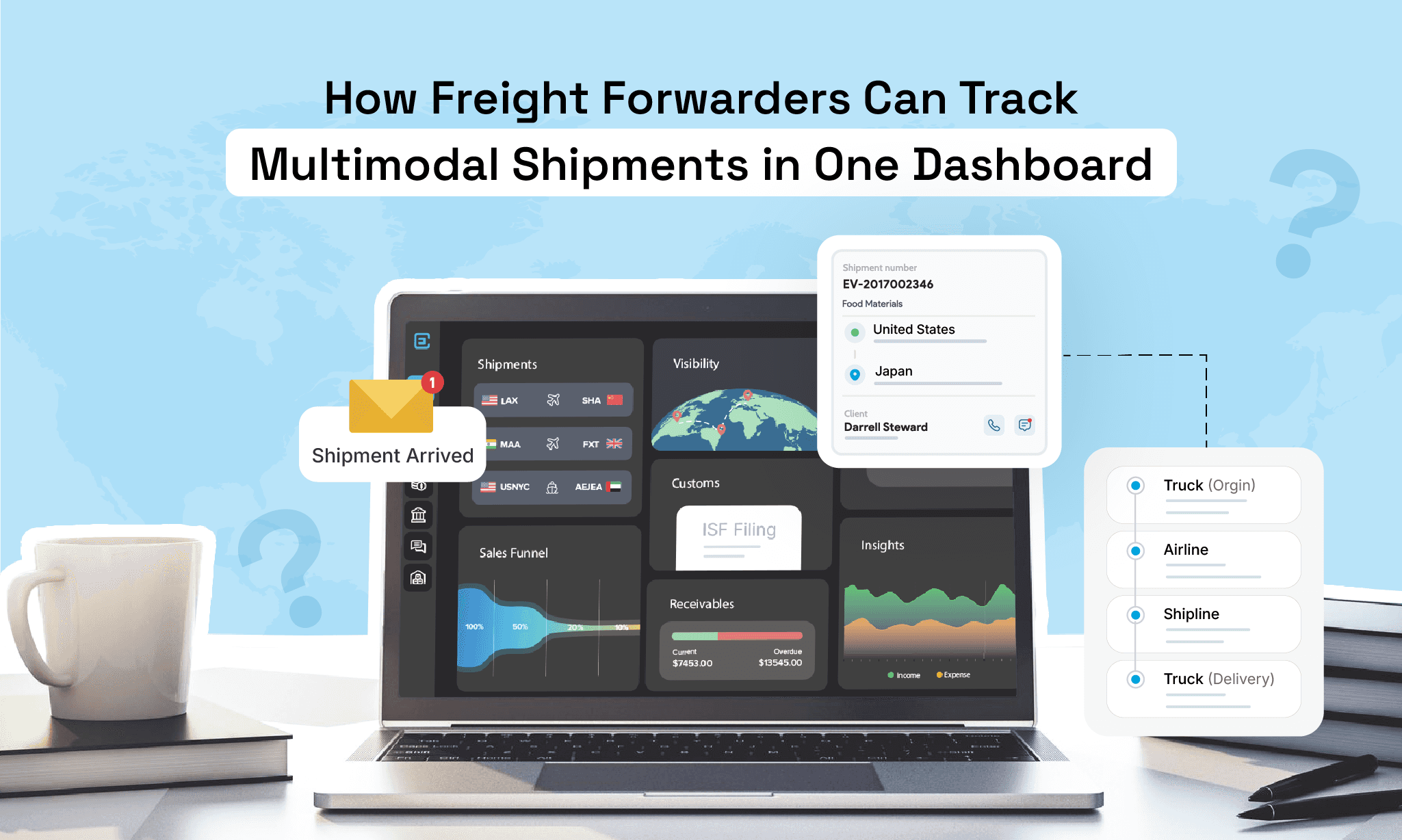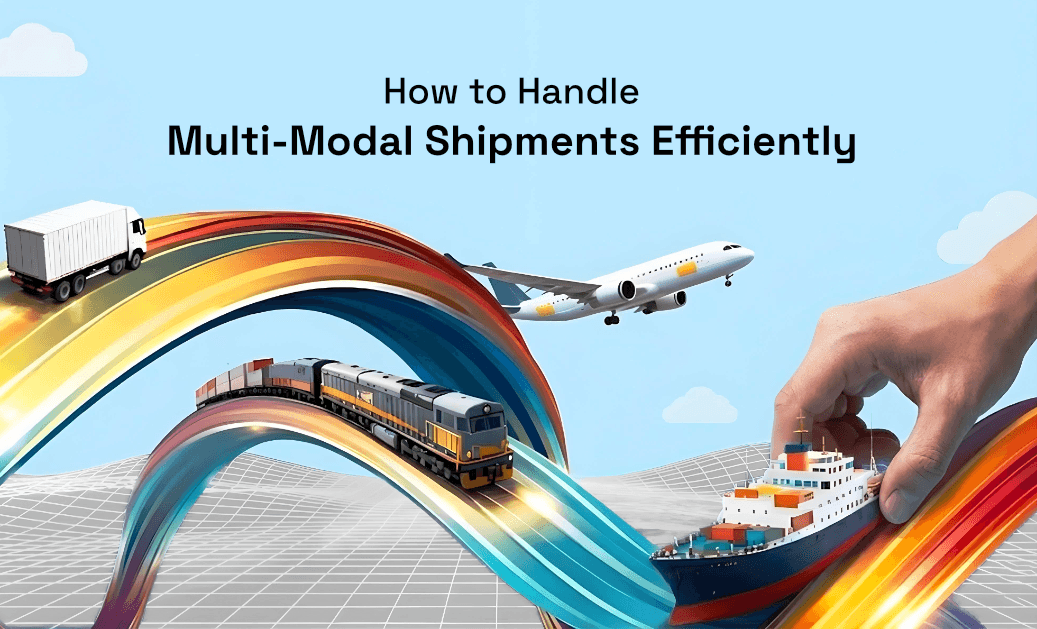Electronic Air Waybill (eAWB) Explained: Types, Uses, and How It Works
Author:
Dharshini Balamurugan
Published On:
Jun 2, 2025
1 min read
Every day, over 100,000 air waybills are processed globally and most of them still on paper. In an industry where minutes matter and margins are tight, relying on outdated paperwork can slow everything down. As the industry evolves to embrace digital solutions, the traditional paper air waybill is being replaced by its electronic counterpart: the electronic Air Waybill, or eAWB.
Electronic air waybills (eAWBs) are the digital alternatives to traditional paper air waybills, facilitating faster and more efficient air cargo operations.
But what exactly is an eAWB?
How does it work?
What are its types, and why is it such a game-changer in the logistics and freight forwarding industry?
This comprehensive guide breaks down everything you need to know about eAWBs—how they work, their advantages, their types, and how they’re transforming air cargo for the better.
What is an Air Waybill (AWB)?
An Air Waybill (AWB) is a critical document in the air cargo industry. It serves as:
A contract of carriage and a legally binding agreement between the shipper and the airline
A receipt for the goods being transported
A document of title, although not negotiable like a bill of lading
A customs declaration in some countries
Traditionally, air waybills have been paper documents that accompany cargo shipments, providing details about the sender, recipient, cargo contents, route, and shipping terms.
However, as paper processes slow down operations, increase costs, and introduce room for error, the move towards digitization has given rise to the eAWB.
What is an eAWB?

An electronic Air Waybill (eAWB) is the digital version of the traditional air waybill. Introduced by IATA (International Air Transport Association), the eAWB enables freight forwarders and airlines to manage air cargo documentation electronically, eliminating the need for physical paperwork.
With the eAWB, information is transmitted digitally using Electronic Data Interchange (EDI) or similar platforms. These electronic messages support faster, more accurate, and more efficient cargo operations.
Why was the eAWB Introduced?
The eAWB was introduced to modernize air cargo processes. Paper air waybills involve printing, signing, copying, and storing—a time-consuming and error-prone process. The eAWB is an essential document in modern air cargo operations, streamlining processes and reducing errors.
The digital alternative:
Simplifies document handling
Reduces delays and transmission errors
Saves operational costs
Supports global sustainability goals
Improves data quality by reducing manual entry errors
In a world where speed, accuracy, and compliance are non-negotiable, eAWB emerged as a much-needed upgrade.
What does AWB Contain?
An Air Waybill (AWB) is the core document that keeps air freight moving smoothly. The air waybill contains everything you need to know about the shipment. The AWB contains all necessary shipment information and detailed information about the goods being transported, ensuring proper handling and tracking. Let’s break down what makes it so important:
Contract of Carriage: It’s the official agreement between the shipper and the airline. It lists the terms and conditions under which the goods will be transported.
Proof of Receipt: Once signed, it serves as legal proof that the airline has received the goods. This comes in handy if there are ever any disputes.
Tracking: Every air waybill comes with a unique number. This 11-digit code is what helps you track the shipment in real time. It also includes the route and relevant airport codes.
Contact Info: It lists contact details for everyone involved—from shipper to consignee—making coordination easier.
Freight Bill: It outlines the charges related to the shipment. In most cases, the air waybill doubles up as an invoice and supports your billing process.
Customs Declaration: Customs authorities need this document to approve and clear the shipment, so it’s a must-have.
Cargo Description: Everything from quantity and weight to dimensions and value of the goods is clearly mentioned.
Shipment Value: The declared value of the goods for customs purposes.
Handling Instructions: Special cargo? Whether it’s fragile, hazardous, or temperature-sensitive, the AWB can include specific handling notes.
Insurance Certificate: If the cargo is insured, this section outlines the coverage details.
Air Waybill [AWB] Number
The AWB number is usually found at the top right corner. It follows this format:
First 3 digits – Airline prefix (e.g., the carrier’s ID)
Next 7 digits – Serial number
Final digit – A check digit (used to validate the number)
Example: 518-41020103 Here, 518 is the airline code (Canadian North), 4102010 is the serial, and 3 is the check digit.
AWB vs Bill Of Lading [BOL] – What’s the Difference?
If you’re used to ocean freight, the AWB (air waybill) might remind you of a Bill of Lading (BOL)—and you’re not wrong. It’s a similar legally binding document, and in some ways, AWBs are considered a type of BOL. However, while bills of lading serve as legal documents that detail the transaction, ownership, and rights associated with the shipment, the AWB is non-negotiable and primarily acts as a receipt for transportation. This means the AWB does not confer ownership or facilitate the transfer of goods between parties.
Key Components of an eAWB
While an eAWB is digital, it contains the same core information as a paper AWB:
Shipper and consignee details
Airport of origin and destination
Flight details
Description of goods
Handling instructions
Freight and charge details
These details are formatted and transmitted electronically, often through IATA-compliant formats and secure EDI channels.
Types of Air Waybills
There are primarily two types of air waybills, both of which have digital versions under the eAWB framework:
MAWB (Master Air Waybill) | HAWB (House Air Waybill) |
|---|---|
Issued by the airline transporting the goods, the Master Air Waybill (MAWB) covers bulk shipments, including a consolidated shipment that may include multiple smaller shipments from various shippers. | Issued by a freight forwarder, the House Air Waybill (HAWB) serves as a consignment note and proof of receipt between the freight forwarder and the individual shipper. It corresponds to one individual shipment within a consolidated load covered by the MAWB. Both Master Air Waybill [MAWB] and House Air Waybill [HAWB] are digitized in eAWB workflows to ensure traceability, efficiency, and accuracy across the air cargo chain. |
How Does eAWB Work?

The eAWB workflow involves the following steps:
Agreement Between Parties
A multilateral or bilateral agreement between the shipper, forwarder, and airline sets the terms for eAWB usage.
Data Preparation
Shipment data is prepared by the freight forwarder or shipper in a digital format, usually through a cargo management platform.
Electronic Submission
The data is sent to the airline via EDI or API, along with all required details for Master Air Waybill/House Air Waybill.
Validation
The airline system checks for data accuracy and completeness. Any errors can trigger retransmission requests.
Transmission to Stakeholders
Once validated, the eAWB is shared with customs, ground handlers, and destination agents.
Tracking and Updates
Stakeholders receive real-time status updates and shipment tracking as the cargo moves through different checkpoints.
Secure Archival
eAWBs are stored in secure digital repositories for future reference, audits, and compliance.
Benefits of Using Electronic Air Waybill

1. Faster Processing
eAWBs eliminate the need for paper documents, streamlining workflows from origin to destination. With fewer manual steps, shipments move faster through each stage of the air cargo process.
2. Improved Accuracy
Automated data validation reduces the risk of human error and ensures that every detail is consistent across systems. This leads to fewer shipment delays and smoother customs clearance.
3. Eco-Friendly
By going digital, companies drastically reduce their paper consumption and carbon footprint. It’s a simple step toward more sustainable and responsible cargo operations.
4. Cost-Effective
No more printing, storing, or couriering physical documents—just direct savings. The reduced administrative workload also means better use of staff and resources.
5. Real-Time Updates
eAWBs enable instant updates on shipment status, improving visibility across the supply chain. With better access to real-time data, teams can plan and respond more effectively.
6. Simplified Workflow
Forget the hassle of moving physical documents across countries or departments. eAWBs centralize documentation, making global operations more seamless and stress-free.
Global Adoption and Challenges
While the adoption of eAWB is growing steadily, it is not yet universal. Different airlines, freight forwarders, and customs agencies are at various stages of readiness.
Challenges include:
Inconsistent regulations across countries
Resistance to change from traditional operators
Technical integration issues, including low-quality electronic messages and complexities in connecting with multiple airlines
Staff training requirements
Ground handling agents face challenges due to poor standardization in eAWB processes, contributing to inefficiencies
Despite this, industry leaders continue to push for global eAWB adoption, recognizing its undeniable benefits in the long run.
eAWB vs Paper AWB: A Quick Comparison
Feature | Paper AWB | eAWB |
|---|---|---|
Format | Physical | Digital |
Processing Time | Slower | Instant |
Error Rate | Higher | Lower, improving data quality |
Cost | High (printing, storage) | Low (paperless) |
Environmental Impact | High | Low |
Real-Time Visibility | Limited | Full |
Compliance Management | Manual | Automated |
How eAWB Supports Customs Clearance
One of the lesser-discussed yet critical benefits of eAWB is its role in import customs clearance. By providing accurate, digitized data to customs authorities in advance, eAWBs:
Speed up clearance processes
Reduce manual inspections
Help avoid documentation-related delays
eAWBs serve as essential customs documents, providing accurate data for faster clearance processes.
In many cases, customs authorities now prefer or mandate digital documentation for faster processing.
Future of eAWB: What’s Next?

As technology continues to advance, eAWB systems are expected to become even more robust. Future advancements in e AWB implementation could include:
AI-powered validation for zero-error filings
Blockchain for enhanced traceability and security
Universal platform interoperability
Greater regulatory harmonization globally
The end goal? A truly paperless, borderless cargo world.
How to Transition to eAWB
If you’re a freight forwarder or logistics provider still relying on paper AWBs, transitioning to eAWB is not as daunting as it seems.
Steps include:
Assess current documentation workflows
Choose a digital freight documentation platform
Transitioning to eAWBs involves integrating them within the broader supply chain workflows for enhanced efficiency.
Train your team on eAWB procedures
Start with bilateral agreements and gradually expand
Monitor results and refine your process for effective e awb implementation
Digital transformation takes effort, but the long-term efficiency and accuracy gains are worth it.
Conclusion
The electronic Air Waybill (eAWB) is a powerful step toward modernizing the air cargo industry. It speeds up processes, reduces errors, saves money, and aligns with global sustainability goals. As more carriers and forwarders go digital, eAWB will soon become the standard for air freight documentation. eAWBs are revolutionizing air shipping by streamlining documentation and improving efficiency.
And while making the transition may seem challenging, the right digital tools can ease the process.
For many freight forwarders, keeping up with shifting airline regulations and tracking AWBs across disconnected systems can be more time-consuming than the shipment itself. Platforms like CargoEZ, with built-in eAWB software, include capabilities that help streamline these tasks quietly in the background—digitizing filings, ensuring compliance, and improving visibility, all while reducing the need for manual follow-ups.
It’s time to leave behind the paper trail—and let your cargo take off, error-free.
Frequently Asked Questions (FAQs)
1. What is an eAWB?
An eAWB (electronic Air Waybill) is the digital version of a traditional paper air waybill. It serves as a contract of carriage, receipt of goods, and customs declaration—all in a digital format.
2. Is an eAWB legally valid?
Yes, eAWBs are legally recognized documents, introduced and standardized by IATA. They are used globally in air cargo operations.
3. How does an eAWB differ from a paper AWB?
Unlike the paper AWB, which is a physical document, an eAWB is transmitted electronically via secure systems (like EDI or APIs). It enables faster processing, better accuracy, and reduces paper use.
4. Do eAWBs apply to all types of shipments?
Yes, eAWBs can be used for all general cargo, but exceptions may exist for specific countries or types of goods requiring physical documentation due to local regulations.
5. What’s the difference between MAWB and HAWB?
MAWB (Master Air Waybill): Issued by the airline to cover consolidated shipments.
HAWB (House Air Waybill): Issued by the freight forwarder for each individual shipment within the consolidation. Both can be digitized as part of the eAWB process.
6. How do I start using eAWBs in my business?
You'll need a freight management system or cargo platform that supports eAWB creation and transmission, along with agreements with participating airlines and proper IATA documentation setup.
7. Can eAWBs be used for customs clearance?
Yes. eAWBs help expedite customs clearance by allowing pre-arrival data submission, improving transparency, and reducing delays at borders.
8. What happens if there’s an error in the eAWB?
Most systems validate data before final submission. If an error occurs, the airline or customs may request corrections or re-submission digitally.
Don't forget to share this blog!



